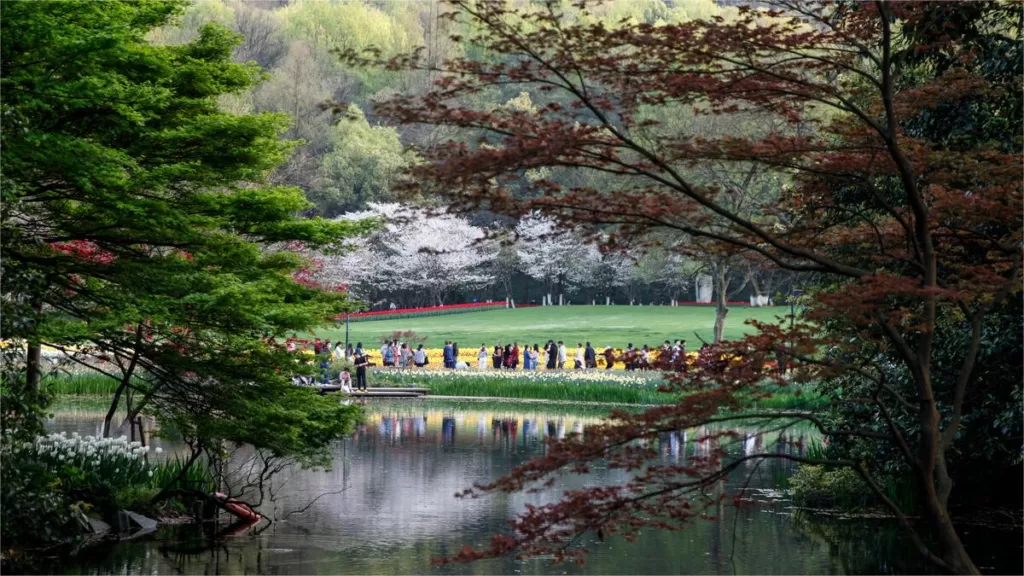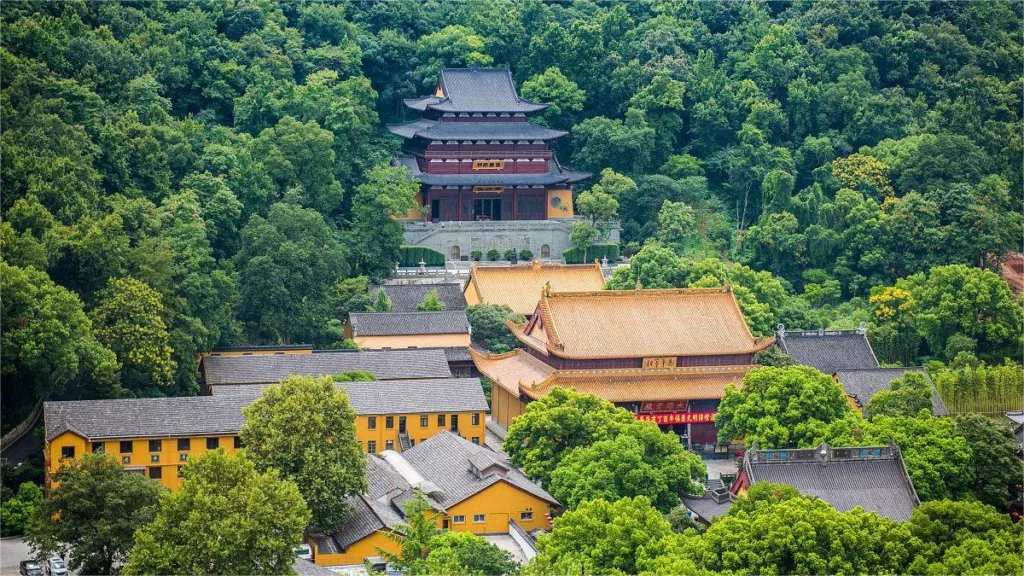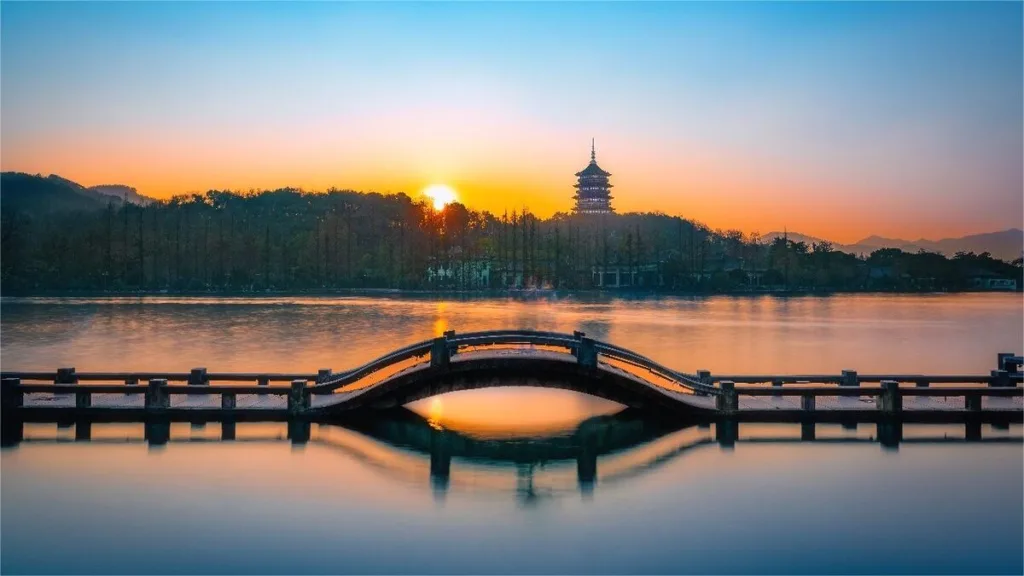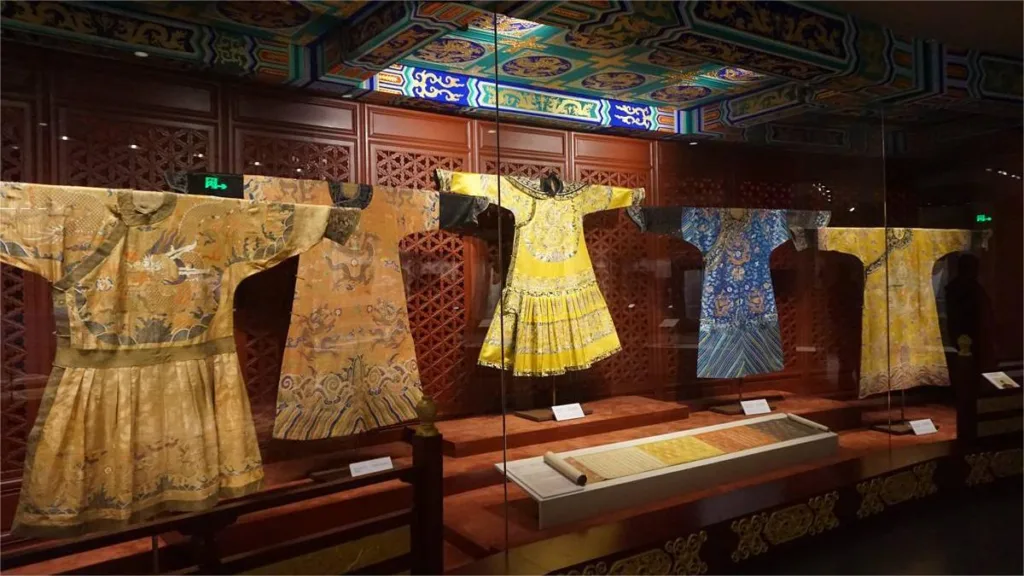Leifeng Pagoda (雷峰塔), originally known as Huangfei Pagoda and also referred to as the West Lake Brick Pagoda, stands proudly atop Xizhao Mountain on the southern bank of West Lake Scenic Area. It was commissioned by Qian Chu, the king of Wuyue, to enshrine the sarira (relics) of Buddha’s crown and to pray for the prosperity and safety of the nation. Some sources suggest that it was also built to celebrate the birth of the king’s son. The pagoda was first constructed in the second year of the Northern Song Dynasty’s Taiping Xingguo era (977 AD) and has undergone several renovations throughout its history. The current structure, based on the original Leifeng Pagoda, was reconstructed in 2002.
Designed with an octagonal floor plan mimicking the architectural style of Tang and Song dynasties, the pagoda has copper-tiled roofs with eaves and corners pointing upwards. It consists of a base with two levels below ground, followed by five above-ground levels. The total height is 71.679 meters, with the base measuring 9.7 meters, the pagoda body reaching 45.809 meters, and the spire standing at 16.10 meters.
During sunset, the pagoda casts a breathtaking silhouette across the sky, creating a scene known as the “Leifeng Sunset Glow.” As one of the “Top Ten Scenes of West Lake” and one of China’s nine renowned pagodas, Leifeng Pagoda stands as the country’s first color-copper sculpted treasure pagoda.
Table of Contents
- Basic Information
- Location and Transportation
- Highlights of Leifeng Pagoda
- Vlog about Leifeng Pagoda
- Attractions near Leifeng Pagoda
Basic Information
| Estimated Length of Tour | 1 – 2 hours |
| Ticket Price | 40 RMB |
| Opening Hours | 8.00 – 17.30; Last admission: 17.00 (1st November -15th March) 8.00 – 19.00; Last admission: 18.30 (16th March – 30th April) |
| Telephone Number | 0086-0571-87982111 |
Location and Transportation
Leifeng Pagoda is situated on the southern bank of the West Lake Scenic Area, adding to the picturesque landscape of the renowned West Lake. The specific address of Leifeng Pagoda is 15 Nanshan Road, Xihu District, Hangzhou, Zhejiang Province. To get there, you can choose one of the following ways:
Bus: Take bus 4, 139, 315, 1314, or West Lake Inner Circle Line and get off at Jingsi Temple Stop (静寺站).
Metro: The closest metro station of Leifeng Pagoda is Wushan Square (吴山广场) on line 7. After getting out of the station from Exit C, transfer to Bus No. 4 or a taxi to cover the remaining 2.5 kilometers.
Highlights of Leifeng Pagoda
Exhibitions on the Floors in Leifeng Pagoda

Leifeng Pagoda offers a rich cultural experience through its various exhibitions spanning the different levels of the pagoda. Upon entering the pagoda’s first floor, visitors are greeted by a prominent gold plaque bearing the calligraphy of the renowned artist Qigong, with the characters “Leifeng Pagoda” elegantly inscribed. The floor itself is paved with glass, revealing the protective layer beneath, safeguarding the archaeological remains of the Leifeng Pagoda site.
Between the first and second floors lies a concealed space featuring intricate wood carvings from Dongyang, depicting the legendary love story of Bai Niangzi and Xu Xian from the classic Chinese tale “Legend of the White Snake” (白蛇传). The exhibition employs a unique “layered carving” style that enhances the storytelling of the White Snake legend and vividly portrays the characters involved.
The second floor showcases cultural exhibits centered around the “Wuyue Constructing Pagoda” painting, providing insights into the historical and artistic aspects of pagoda construction.

Moving up to the third floor, visitors encounter a collection of four stone tablets, each displaying three poems, totaling 12 carefully selected verses praising Leifeng Pagoda and its enchanting sunset views. Accompanied by illustrations and carvings, these poetic works span various dynasties and contribute to the appreciation of the pagoda’s cultural significance.
The fourth floor of Leifeng Pagoda offers a unique exhibition named “West Lake’s New Look,” featuring sculpture displays that depict scenes from the ten famous landscapes around West Lake.
Ascending to the fifth floor, visitors encounter a stunning golden dome adorned with a large lotus at its center, symbolizing purity and expressing a universal wish for peace. Above the dome, a hidden chamber houses a celestial palace containing memorabilia and texts intending to pass down to future generations. Notable items include the reconstruction history of Leifeng Pagoda, a realistic model of the new pagoda, and other commemorative artifacts. The fifth-floor walls are adorned with numerous small niches, each containing a golden-painted stupa. In total, there are 2002 stupas, symbolizing and commemorating the reconstruction of Leifeng Pagoda in the year 2002.
Leifeng Sunset Glow

One of the “Top Ten Scenes of West Lake,” the Leifeng Sunset Glow, or “雷峰夕照” in Chinese, derives its name from the poem “Zhong Feng (Leifeng)” by the Northern Song poet Lin Bu. The term gained prominence when renowned artists, including Chen Qingbo, created landscape paintings of West Lake during the Southern Song Dynasty. Chen Qingbo’s masterpiece depicting the Leifeng Pagoda and its surroundings was aptly titled “Leifeng Sunset Glow.” Over the centuries, scholars and literati have celebrated the captivating scenery of the Leifeng Sunset Glow, with the Qing Emperor Kangxi even inscribing a poem during his southern tour to Hangzhou, further immortalizing the beauty of the sunset.
Legend of the White Snake

Embedded in Chinese folklore, the “Legend of the White Snake” is intricately tied to Leifeng Pagoda. Set in the Song Dynasty in Zhenjiang, the tale revolves around Bai Suzhen, a thousand-year-old snake demoness, who transforms into a human to repay the kindness shown by a scholar named Xu Xian. Bai Suzhen and her companion, the green snake spirit Xiaoqing, embark on a journey together. The narrative unfolds as Bai Suzhen employs magical powers to cleverly encounter Xu Xian, eventually marrying him. However, their happiness is disrupted when the monk Fahai reveals Bai Suzhen’s true identity as a snake demoness.
Fahai convinces Xu Xian to test Bai Suzhen’s true form by giving her wine laced with realgar during the Dragon Boat Festival. Unveiling her serpent nature, Bai Suzhen accidentally frightens Xu Xian to death. Distraught, she ascends to the heavens, steals magical herbs, and resurrects Xu Xian. The story intensifies as Fahai captures Xu Xian, prompting Bai Suzhen and Xiaoqing to confront him. Their magical battle leads to flooding the Jinshan Temple, causing harm to other beings. In punishment, Bai Suzhen is imprisoned beneath Leifeng Pagoda. The narrative reaches its climax when Bai Suzhen’s son, having grown into a talented scholar, frees his mother from captivity, reuniting the family.







